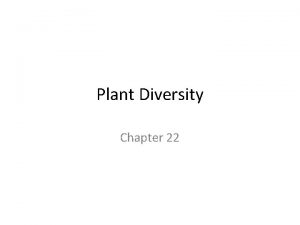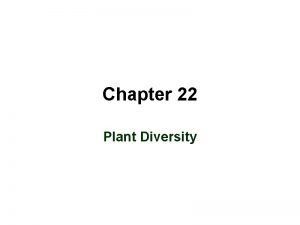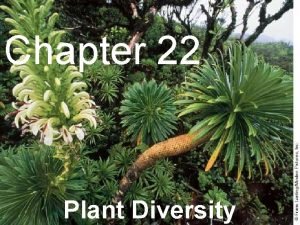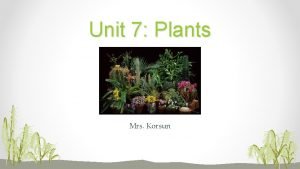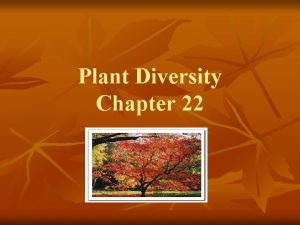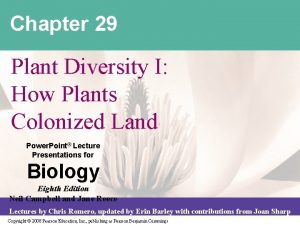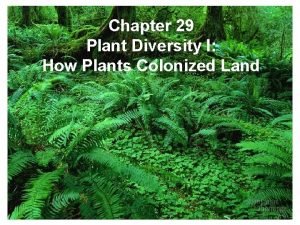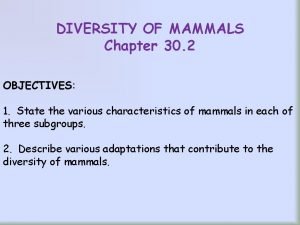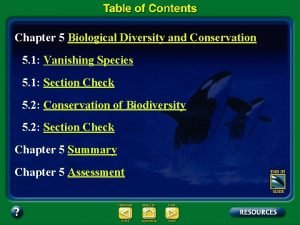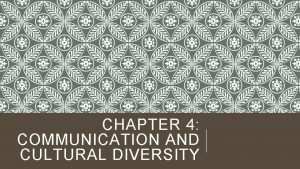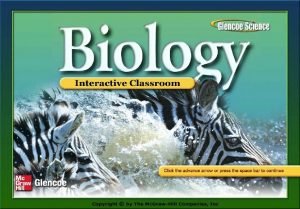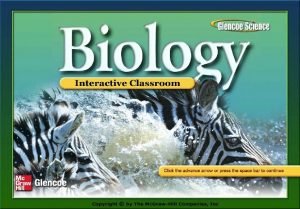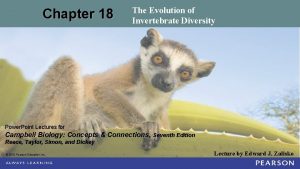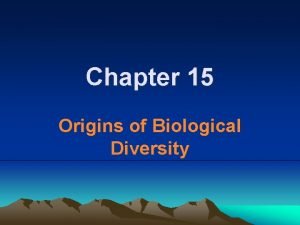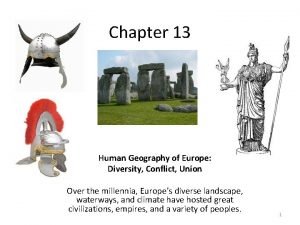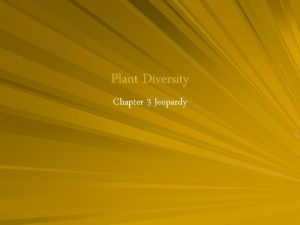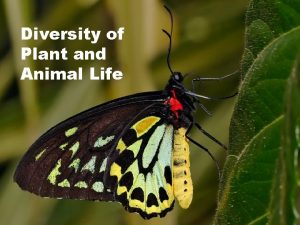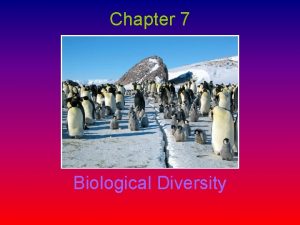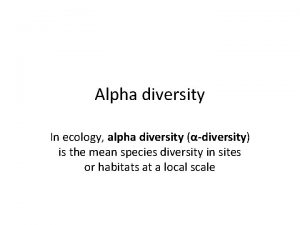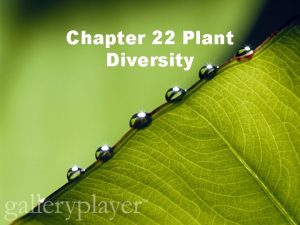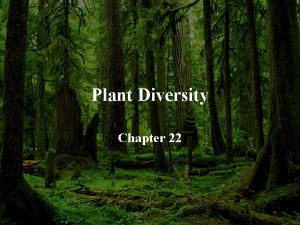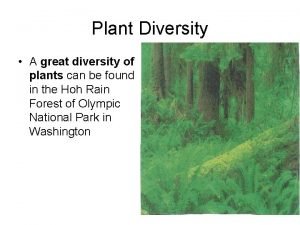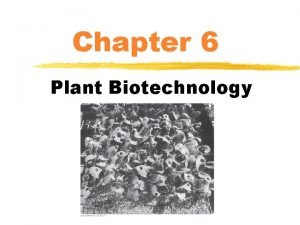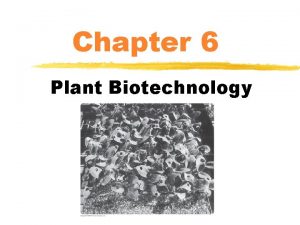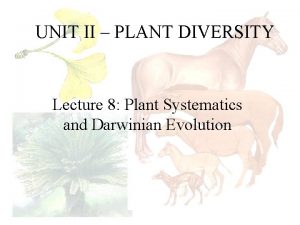Plant Diversity Chapter 22 What is a Plant





















- Slides: 21

Plant Diversity Chapter 22

What is a Plant? n n Members of the Kingdom Plantae They are divided into 4 groups: Bryophytes, Ferns, Gymnosperms, and Angiosperms They have cell walls made of cellulose Carry out photosynthesis using chlorophyll

Plant Life Cycle n Alternation of generations: n Diploid phase: sporophyte or spore producing plant n meiosis n Haploid phase: gametophyte or gamete producing plant n mitosis

n

Bryophytes n n n Mosses and their relatives Nonvascular plants: do not have vascular tissue (system of transport tubes) that conduct water and nutrients Depend on water for reproduction Osmosis Mosses, Liverworts, Hornworts

Bryophytes n n http: //videos. howstuffworks. com/discovery /30695 -assignment-discovery-bryophytesvideo. htm http: //www. youtube. com/watch? v=jc. WYA nmm-QE

n

Plants with Vascular Systems n n A vascular system is a system of tubes to transport water and nutrients in a plants Includes Ferns, Gymnosperms, and Angiosperms. Ferns are Seedless Vascular Plants Gymno and Angiosperms are Vascular Seed Producing Plants

Vascular Plants Tissues n n n Tracheids: cell that is specialized to conduct water Xylem: carries water upward from the roots to every part of a plant Pholem: Transports solutions of nutrients and carbohydrates

n

Ferns and their relatives n n Include club mosses, horsetails, and ferns Seedless vascular plants - they produce spores Have true roots, leaves, and stems http: //videos. howstuffworks. com/discovery /30696 -assignment-discovery-fernsvideo. htm


Vascular Seed Plants n n Divided into two groups: Gymnosperms and Angiosperms

Seed Plants n n n Gymnoperms: bear seeds directly on the surface of cones http: //www. youtube. com/watch? v=D 9 by. V Qxv. MXs http: //videos. howstuffworks. com/discovery /30697 -assignment-discoverygymnosperms-video. htm

Seed Plants n n Angiosperms: flowering plants that bear their seeds within a layer of tissue that protects the seed http: //videos. howstuffworks. com/discovery /27703 -assignment-discovery-angiospermsvideo. htm

Seed Plant Reproduction n Includes: n n n Flowers or cones Pollen grain (male) http: //videos. howstuffworks. com/discovery/3 0702 -assignment-discovery-plantreproduction-video. htm

Angiosperm Diversity Monocots – 1 seed leaf

Dicots – 2 seed leaves n

n n n Annuals: complete a life cycle only in one growing season. Biennials: complete their life cycle in two years Perennials: live for more than two years

PLANT ANATOMY Cuticle Veins Epidermis Palisade Mesophyll Xylem Phloem Vein Spongy Mesophyll Epidermis Stoma Guard Cells

 Why is genetic diversity important
Why is genetic diversity important Genetic diversity vs species diversity
Genetic diversity vs species diversity Chapter 22 plant diversity
Chapter 22 plant diversity Chapter 22 plant diversity answer key
Chapter 22 plant diversity answer key Chapter 22 plant diversity answer key
Chapter 22 plant diversity answer key Chapter 20 plant diversity
Chapter 20 plant diversity Plant diversity chapter
Plant diversity chapter Life cycle of seedless plants
Life cycle of seedless plants Chapter 29 plant diversity
Chapter 29 plant diversity Chapter 30 section 2 diversity of mammals
Chapter 30 section 2 diversity of mammals Chapter 9 cultural competence
Chapter 9 cultural competence Chapter 8 study guide human resources culture and diversity
Chapter 8 study guide human resources culture and diversity Chapter 8 study guide human resources culture and diversity
Chapter 8 study guide human resources culture and diversity Chapter 5 diversity and human needs and development
Chapter 5 diversity and human needs and development Chapter 5 biological diversity and conservation
Chapter 5 biological diversity and conservation Chapter 4 communication and cultural diversity
Chapter 4 communication and cultural diversity Chapter 30 section 1 mammalian characteristics
Chapter 30 section 1 mammalian characteristics Chapter 26 section 1 arthropod characteristics answer key
Chapter 26 section 1 arthropod characteristics answer key Chapter 18 the evolution of invertebrate diversity
Chapter 18 the evolution of invertebrate diversity Chapter 15 origins of biological diversity answers
Chapter 15 origins of biological diversity answers Diversity in the uk
Diversity in the uk 2009 delmar cengage learning
2009 delmar cengage learning


